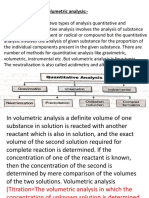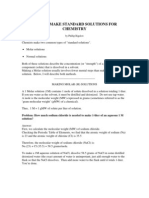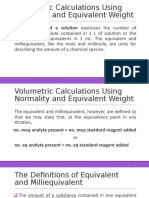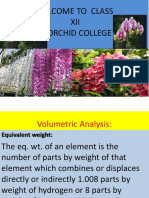What Is A Molar Solution
What Is A Molar Solution
Uploaded by
Naqeeb UllahCopyright:
Available Formats
What Is A Molar Solution
What Is A Molar Solution
Uploaded by
Naqeeb UllahOriginal Description:
Original Title
Copyright
Available Formats
Share this document
Did you find this document useful?
Is this content inappropriate?
Copyright:
Available Formats
What Is A Molar Solution
What Is A Molar Solution
Uploaded by
Naqeeb UllahCopyright:
Available Formats
What is a Molar Solution?
And Preparation
Molarity is another standard expression of solution concentration. Molar solutions use the gram molecular weight of a solute in
calculating molar concentration in a liter (L) of solution.
The gram molecular weight (GMW) of a substance (sometimes called the "formula weight") is the sum of the combined atomic
weights of all atoms in the molecule expressed in grams. For example, the GMW of NaCl is equal to the atomic weight (these
atomic weights may be found on a periodic table or as a formula weight on the bottle of substance) of Na (22.99) and the atomic
weight of Cl (35.45) for a total of 58.44 g.
A 1 molar (M) solution will contain 1.0 GMW of a substance dissolved in water to make 1 liter of final solution. Hence, a 1M
solution of NaCl contains 58.44 g.
Example: HCl is frequently used in enzyme histochemistry. The GMW of HCl would be the atomic weight of H
added to the atomic weight of Cl: H = 1 + Cl = 35.45 = 36.45 g. A liter of 1M solution of HCl would contain 36.45 g.
Monosodium di-hydrogen phosphate (NaH2PO4) buffer is also used in enzyme histochemistry. A liter of 1M solution of
NaH2PO4 would contain Na (22.99) + 2 H (1x2=2) + P (30.97) + 4 O (16x4=64) for a total GMW of 119.98 g.
To simply calculate the amount or weight of a substance needed for a desired molar solution, the following formula may be used:
Weight in grams = desired molarity x volume needed in liters x GMW
-- OR --
(W = M x V x GMW)
Example: 500 mL of a 0.1M solution of NaOH is needed for a procedure. Calculate the amount of solute (NaOH) needed
to prepare the solution. (Atomic weights: Na = 22.99; O = 16; H = 1)
X g = 0.1M x 500 mL x GMW 39.99
X = 0.1 x 0.5 x 39.99
X = 1.9995 or 2
2.0 g of NaOH must be diluted to 500 mL to prepare a 0.1M solution. (1L= 1000mL)
Molarity (M) = 𝒏⁄𝑽
Here M is molarity in Mole per Liter 𝒎𝒐𝒍⁄𝑳
n is number of moles of solute in moles
And the V is the volume in Liter
1) How many grams of NaOH (GMW = 40) are needed to prepare 750 mL of a 0.5M
solution?
What is a Normal Solution? And preparation
Normality (N) is another way to quantify solution concentration. It is similar to molarity but uses the gram-equivalent weight of
a solute in its expression of solute amount in a liter (L) of solution, rather than the gram molecular weight (GMW) expressed in
molarity. A 1N solution contains 1 gram-equivalent weight of solute per liter of solution.
Expressing gram-equivalent weight includes the consideration of the solute's valence. The valence is a reflection of the combining
power of an element often as measured by the number of hydrogen atoms it can displace or combine with. A 1.0 gram-equivalent
weight is the amount of a substance that will combine with or displace 1 atom of hydrogen.
To determine gram-equivalent weight of a substance:
Divide the GMW (formula weight) of a solute by the valence (number of hydrogen ions that can be displaced).
Example: The normality of a 1.0 liter NaCl solution that contains 1.0 gram-equivalent weight will be the GMW of NaCl divided
by the valence of NaCl:
(Atomic weight of Na = 22.99; atomic weight of Cl = 35.45)
GMW of NaCl = 22.99 + 35.45 = 58.44 g
N = GMW/valence (the valence for NaCl is 1.0)
58.44 g/1.0 = 58.44 g = 1.0 gram-equivalent weight of NaCl = 1N solution of NaCl
In this situation, because NaCl has a valence of one, the molarity and normality of the solution are the same.
Some compounds, however, will not have the same normality as molarity, as in the case of H2SO4:
Example:
The normality of a 1.0 liter solution of H2SO4 containing 1.0 gram-equivalent weight will be the molecular weight of
H2SO4 divided by the valence of H2SO4:
(Atomic weight of H = 1; atomic weight of S = 32.06; atomic weight of O = 16)
GMW of H2SO4 = 1(2) + 32.06 + 16(4) = 98 g
N = GMW/valence (the valence for H2SO4 is 2.0, as there are 2.0 H ions that could be displaced)
98 g /2 = 49 g = 1.0 gram-equivalent weight of H2SO4 = 1N solution of H2SO4
The molarity of this 1N solution of H2SO4 would be 0.5 (M = g /GMW per liter or 49g/98g = 0.5)
To simply calculate the amount or weight of a substance needed for a desired normalsolution, the following formula may be used:
Weight in grams = desired normality x volume needed in liters x GMW/valence
(W = N x V x GMW/valence)
Example:
500 mL of a 0.1N solution of NaOH is needed for a procedure. Calculate the amount of solute (NaOH) needed to prepare the
solution. (Atomic weights: Na = 22.99; O = 16; H = 1) Valence = 1
X g= 0.1N x 500 mL (0.5 L) x GMW 39.99 / 1.0
X = 0.1 x 0.5 x 39.99/1.0
X = 1.99
1.99 g of NaOH must be diluted to 500 mL to prepare a 0.1N solution.
Interchanging of Molarity and Normality Concentrations
When working in the histology laboratory, it may be helpful at times to simply convert an existing concentration of substance to
another type of concentration to meet the reagent needs of a procedure. The inter-conversion of molarity and normality sometimes
needs to be performed by the histotechnician.
Example:
A 3M solution of NaOH is found on the supply room shelf. The histotechnician is curious what the normality would be for that
solution, as she needs 2N NaOH. What is the normality of the 3M NaOH solution?
When doing normal/molar conversions, remember when the valence is one, normality and molarity are the same.
Valence of NaOH = 1
Normality = valence x molarity
N = 1 x 3M = 3
N=3
The normality of the 3M solution of NaOH is 3N.
Example:
Given a 4N solution of H2SO4, a histotechnologist needs to quickly know the molarity of this solution.
Valence of H2SO4 = 2
Molarity = normality / valence
M = 4/2
M=2
The molarity of a 4N solution of H2SO4 is 2M.
Molarity, Molality and NormalityBy Roberta C. Barbalace
The quantitative relationship between chemical substances in a reaction is known as stoichiometry. Avogadro was a pioneer in
this field of chemistry. Avogadro hypothesized that there was a specific number that would represent the number of atoms or
molecules in a mole of that atom or molecule. The weight of that unit known as a mole would be equivalent to the atomic or
molecular weight of the atom or molecule in grams. According to this theory, one mole of carbon-12 would have a mass of 12
grams because carbon-12 has an atomic weight of 12 (6 neutrons and 6 protons). One mole of hydrogen would weigh one gram
and would contain the same number of atoms as one mole of carbon. The magical number was, in fact, discovered to be 6.024E 23.
It was named the Avogadro Number in honor of the father of stoichiometry even though he did not actually determine the exact
number. The modern definition of a mole is as follows:
Exactly one mole represents the number of carbon atoms in exactly 12 grams of the carbon-12 isotope.
For an atom a mole represents 6.02E23 atoms. For a molecular compound, one mole represents 6.02E23 molecules. One could
even take it to extremes and say that one mole of bananas is equal to 6.02E23 bananas.
Now you might ask, "what relevance does the Avogadro number have for me?" The answer is, just about everything when you are
working in a chemistry lab. On the other hand, it is totally useless as a unit of measure for bananas.
One atom or even ten atoms are too small for an individual to measure out in a lab. A mole of a substance equals the gram-formula
mass or the gram-molar mass. This equals the sum of all of the masses of all the elements in the formula of the substance. Basically,
if one were to count all of the carbon atoms in one one mole of carbon-12, there would be 6.02E23 atoms and it would weigh 12
grams (remember the atomic weight of carbon is 12).
Using the information above, it is possible to calculate concentrations of solutions and make up solutions of desired concentration.
It is also possible to use this information to determine how much of a given base would be needed in order to neutralize a specific
acid and reach a pH of 7.
There are five units of concentration that are particularly useful to chemists. The first three: molality, molarity and normality are
dependant upon the mole unit. The last two: percent by volume and percent by weight have nothing to do with mole, only weight
or volume of the solute or substance to be diluted, versus the weight or volume of the solvent or substance in which the solute is
diluted. Percentages can also be determined for solids within solids.
Molality: The molal unit is not used nearly as frequently as the molar unit. A molality is the number of moles of solute dissolved
in one kilogram of solvent. Be careful not to confuse molality and molarity. Molality is represented by a small "m," whereas
molarity is represented by an upper case "M." Note that the solvent must be weighed unless it is water. One liter of water has a
specific gravity of 1.0 and weighs one kilogram; so one can measure out one liter of water and add the solute to it. Most other
solvents have a specific gravity greater than or less than one. Therefore, one liter of anything other than water is not likely to occupy
a liter of space. To make a one molal aqueous (water) solution of sodium chloride (NaCl) , measure out one kilogram of water and
add one mole of the solute, NaCl to it. The atomic weight of sodium is 23 and the atomic weight of chlorine is 35. Therefore the
formula weight for NaCl is 58, and 58 grams of NaCl dissolved in 1kg water would result in a 1 molal solution of NaCl.
Molarity: The molar unit is probably the most commonly used chemical unit of measurement. Molarity is the number of moles
of a solute dissolved in a liter of solution. A molar solution of sodium chloride is made by placing 1 mole of a solute into a 1-liter
volumetric flask. (Taking data from the example above we will use 58 grams of sodium chloride). Water is then added to the
volumetric flask up to the one liter line. The result is a one molar solution of sodium chloride.
Normality: There is a relationship between normality and molarity. Normality can only be calculated when we deal with
reactions, because normality is a function of equivalents.
The example below uses potassium hydroxide (KOH) to neutralize arsenic acid. By studying the reaction it is possible to determine
the proton exchange number to determine the normality of the arsenic acid.
Look at the equation H3AsO4 + 2KOH --> K2HAsO4 + 2H2O:
Equivalent weight = molar mass/(H+ per mole)
Equivalent = mass of compound / Equivalent weight
And Normality = (equivalents of X)/Liter
And the part that is of interest to you is that Normality = molarity x n (where n = the number of protons exchanged in a reaction).
You probably remember that when a hydrogen atom is ionized and loses its electron, you are left with only a proton. So a hydrogen
ion is basically a proton.
Let's assume that we have a 0.25 M solution of H3AsO4 and want to determine the normality of it if it participates in the reaction
H3AsO4 + 2KOH --> K2HAsO4 + 2H2O
When H3AsO4 is neutralized by KOH, H3AsO4 provides two protons to form 2H2O.
Note that H3AsO4 has three hydrogens, but K2HAsO4 only has one hydrogen. That means that 2 protons were exchanged,
Again normality = molarity * n
Remember that normality of the solution is 0.25 mol H3AsO4 and there were two protons exchanged (2 equivalents/mole)
So, in short, while there is a relationship between the normality of a solution and the molarity of a solution, the normality can only
be determined by examining reaction, determining the proton exchange and multiplying molarity by that number.
Normality is particularly useful in titrations calculations.
Where N = normality, V = volume, a = the substance on the left of the equation involved in proton exchange, and b=substance on
the right of the equation involved in proton exchange:
NaVa = NbVb
Percentages are easy to calculate because they do not require information about the chemical nature of the substance. Percentages
can be determined as percent by weight or percent by volume.
Percent by weight: To make up a solution based on percentage by weight, one would simply determine what percentage was
desired (for example, a 20% by weight aqueous solution of sodium chloride) and the total quantity to be prepared.
If the total quantity needed is 1 kg, then it would simply be a matter of calculating 20% of 1 kg which, of course is:
0.20 NaCl * 1000 g/kg = 200 g NaCl/kg.
In order to bring the total quantity to 1 kg, it would be necessary to add 800g water.
Percent by volume: Solutions based on percent by volume are calculated the same as for percent by weight, except that
calculations are based on volume. Thus one would simply determine what percentage was desired (for example, a 20% by volume
aqueous solution of sodium chloride) and the total quantity to be prepared.
If the total quantity needed is 1 liter, then it would simply be a matter of calculating 20% of 1 liter which, of course is:
0.20 NaCl * 1000 ml/l = 200 ml NaCl/l.
Percentages are used more in the technological fields of chemistry (such as environmental technologies) than they are in pure
chemistry.
You might also like
- An Introduction To Thermal Physics 1st Ed Solution Manual by Schroeder PDFDocument117 pagesAn Introduction To Thermal Physics 1st Ed Solution Manual by Schroeder PDFkevinchu021195No ratings yet
- Experiment 3Document14 pagesExperiment 3mad469469No ratings yet
- Stoichiometry: Stoichiometry (Stoi Chi Om e Try - Stoi'kē-Ŏm'ĭ-Trē) Is A Branch of Chemistry ThatDocument7 pagesStoichiometry: Stoichiometry (Stoi Chi Om e Try - Stoi'kē-Ŏm'ĭ-Trē) Is A Branch of Chemistry ThatJoyline CanlasNo ratings yet
- Molarity, Molality and Normalityby Roberta C. BarbalaceDocument2 pagesMolarity, Molality and Normalityby Roberta C. BarbalaceNaqeeb UllahNo ratings yet
- Solution Concentration UnitsDocument38 pagesSolution Concentration UnitsDarrell W. GarwayNo ratings yet
- Volumetric Analysis I - XIIDocument41 pagesVolumetric Analysis I - XIILàXsun ShrèsthàNo ratings yet
- Volumetric AnalysisDocument39 pagesVolumetric AnalysisYes SirNo ratings yet
- Molarity:: "Moles of Solute Contained in One Liter of Solution Is Known As Molarity"Document4 pagesMolarity:: "Moles of Solute Contained in One Liter of Solution Is Known As Molarity"Civil Engineer PKNo ratings yet
- Unit 2 Concentration Units of ConcentrationDocument11 pagesUnit 2 Concentration Units of Concentrationkarnalhanzalah88No ratings yet
- ChemistryDocument10 pagesChemistrychakatintswalo66No ratings yet
- Unit-2 - Chemical MeasurementsDocument15 pagesUnit-2 - Chemical Measurementsshimmy yayNo ratings yet
- Physics Term 3 NotesDocument26 pagesPhysics Term 3 Noteslesego08tladiNo ratings yet
- Quantitative Chemical Analysis CHM208 - Module 1Document7 pagesQuantitative Chemical Analysis CHM208 - Module 1Abefe AdesojiNo ratings yet
- The Molarity Calculator EquationDocument5 pagesThe Molarity Calculator EquationRama Anil100% (1)
- Solubility and Precipitation NotesDocument12 pagesSolubility and Precipitation Notespaulmwadime505No ratings yet
- ChemmoDocument2 pagesChemmoJake AnthonyNo ratings yet
- Concentration of SolutionsDocument76 pagesConcentration of Solutionsprince3edwardNo ratings yet
- Making Molar & Normal SolutionsDocument10 pagesMaking Molar & Normal Solutionsammuluhai333100% (2)
- Week 4 Physical Properties of Solution PDFDocument40 pagesWeek 4 Physical Properties of Solution PDFmai sasaNo ratings yet
- Chap 3Document22 pagesChap 3Tun Lin AungNo ratings yet
- GLT 121 TOPICS 1aDocument7 pagesGLT 121 TOPICS 1ablessingNo ratings yet
- 03 NormalityDocument49 pages03 NormalityEdna Lip AnerNo ratings yet
- Physical EquilibriaDocument62 pagesPhysical Equilibriamdnishathasan141No ratings yet
- Moles, Titration, RedoxDocument28 pagesMoles, Titration, RedoxDoveNo ratings yet
- Revised Fundamentals of Volumetric AnalysisDocument13 pagesRevised Fundamentals of Volumetric AnalysisMahesh Kumar100% (1)
- Assignment 1 Environmental ScienceDocument2 pagesAssignment 1 Environmental ScienceHaikal IskandarNo ratings yet
- Solutions & ColloidsDocument13 pagesSolutions & ColloidsAbdul QayyumNo ratings yet
- Solutions 1Document17 pagesSolutions 1Febry MiftakhulNo ratings yet
- 4-Molar Solution and Normal SolutionDocument9 pages4-Molar Solution and Normal Solutionyr44grf94kNo ratings yet
- Lecture 3 Physical Properties of SolutionsDocument58 pagesLecture 3 Physical Properties of SolutionsAllen SiaNo ratings yet
- Stoichiometric Calculations: Review of Fundamental ConceptsDocument24 pagesStoichiometric Calculations: Review of Fundamental ConceptsHari Madhavan Krishna KumarNo ratings yet
- LU2 Stoichiometry CalculationDocument67 pagesLU2 Stoichiometry CalculationCarina JL100% (1)
- EXPERIMENT 11 (Preparation of Solution)Document17 pagesEXPERIMENT 11 (Preparation of Solution)ChaNo ratings yet
- Concentration UnitsDocument8 pagesConcentration UnitsAngela Kathlyn SolacitoNo ratings yet
- Chem141 ch01 SZBDocument7 pagesChem141 ch01 SZBVishal VasavdaNo ratings yet
- Pharmaceutical Analytical Chemistry: Dr. Ahmad Najjar Dr. Ibrahim KhatibDocument65 pagesPharmaceutical Analytical Chemistry: Dr. Ahmad Najjar Dr. Ibrahim KhatibSteve LiNo ratings yet
- Solution ChemistryDocument19 pagesSolution Chemistrymba174061No ratings yet
- Basic KonsepDocument45 pagesBasic KonsepAnnisa IstiqomahNo ratings yet
- 18 Quantitative Aspects of Chemical ChangeDocument30 pages18 Quantitative Aspects of Chemical Changeapi-235269401No ratings yet
- Chapter 4 Lecture NotesDocument30 pagesChapter 4 Lecture Notessama abubakerNo ratings yet
- Chemistry Seminar KSJDocument15 pagesChemistry Seminar KSJPriyanshu PatelNo ratings yet
- Quantitative Chemical Analysis: Solution DefinitionDocument8 pagesQuantitative Chemical Analysis: Solution Definitionodubade opeyemiNo ratings yet
- 4 CH 13 Section 4Document18 pages4 CH 13 Section 4Cyrus MsosaNo ratings yet
- 4 CH 13 Section 4 0Document18 pages4 CH 13 Section 4 0Sharanappa ANo ratings yet
- CHEM2 Chapter4-Calculations1Document34 pagesCHEM2 Chapter4-Calculations1CUIZON, GEORDETTE DIVINENo ratings yet
- Basic Formula of ChemistryDocument11 pagesBasic Formula of ChemistryRachit singhNo ratings yet
- Expressions of ConcentrationsDocument36 pagesExpressions of Concentrationsgycht672qdNo ratings yet
- Reagents SolutionsDocument52 pagesReagents SolutionsSimon NyarkoNo ratings yet
- Chapter 3 LectureDocument51 pagesChapter 3 Lecturesandpiper2ndNo ratings yet
- Chemistry ReviewerDocument13 pagesChemistry Reviewermelloglyssa96No ratings yet
- Catabolism of Carbohydrate's and ATP ProductionDocument6 pagesCatabolism of Carbohydrate's and ATP ProductionTahir AzizNo ratings yet
- Unit 2: Chemical Measurements: Topic OutlineDocument20 pagesUnit 2: Chemical Measurements: Topic OutlineJherby TeodoroNo ratings yet
- Water Chemistry NotesDocument4 pagesWater Chemistry NotesWaleed EmaraNo ratings yet
- Methods of Presenting Concentration - Lecture 2Document31 pagesMethods of Presenting Concentration - Lecture 2Acidri Abdulkarim100% (1)
- Chem 4401 l1 UnitsDocument10 pagesChem 4401 l1 UnitsMaanja KhambaNo ratings yet
- Unit 3 Laboratory Math Part 2 - Expressions of ConcentrationDocument2 pagesUnit 3 Laboratory Math Part 2 - Expressions of ConcentrationCheung Ka TikNo ratings yet
- Stoic Hi o MetricDocument13 pagesStoic Hi o Metricdeep_singh234No ratings yet
- Chapter 4 ReagentsDocument53 pagesChapter 4 ReagentsIka Dalu PrasetyawanNo ratings yet
- Volumetric Analysis All Till This DateDocument28 pagesVolumetric Analysis All Till This DateSolomonNo ratings yet
- Chapter 11 SolutionsDocument14 pagesChapter 11 SolutionsVinicius CostaNo ratings yet
- 1 3 Limiting ReagentDocument8 pages1 3 Limiting Reagentapi-327781490No ratings yet
- Agriculture and Vet Unary Sample Admission Test 01 PDFDocument14 pagesAgriculture and Vet Unary Sample Admission Test 01 PDFRahat AfzalNo ratings yet
- STOCHIOMETRYDocument13 pagesSTOCHIOMETRYHARI PRASATHNo ratings yet
- LKM 3 Kel-2 Stoikio MetriDocument16 pagesLKM 3 Kel-2 Stoikio MetriSalsabila AlmasNo ratings yet
- Muchamad Gema Ramadhan - 2440123472 - Kimia - TP2 - W4 - S4 - R0Document4 pagesMuchamad Gema Ramadhan - 2440123472 - Kimia - TP2 - W4 - S4 - R0gema ramadhanNo ratings yet
- Stoichiometry: Stoichen ElementDocument55 pagesStoichiometry: Stoichen ElementKoonj LashariNo ratings yet
- Electric Current: ObjectivesDocument26 pagesElectric Current: ObjectivesBrent Alfred YongcoNo ratings yet
- Physical Chemistry: Shailendra KRDocument6 pagesPhysical Chemistry: Shailendra KR1harshikaNo ratings yet
- Chemistry Jan2012 Unit-3b QPDocument16 pagesChemistry Jan2012 Unit-3b QPAkila RahmanNo ratings yet
- Chapter 1Document8 pagesChapter 1Aryan GuptaNo ratings yet
- Experiment 4 Palvi FinalDocument8 pagesExperiment 4 Palvi FinalSara AliNo ratings yet
- Empirical and Molecular FormulasDocument11 pagesEmpirical and Molecular FormulasWarley JabelNo ratings yet
- Selected Answers For Exercises: Product KG Waste KG EDocument7 pagesSelected Answers For Exercises: Product KG Waste KG EkeatyNo ratings yet
- Solutions ISC QuestionsDocument8 pagesSolutions ISC Questionsjjprakash82chemNo ratings yet
- Spectrophotometric Determination of Iron and Boron in SoilDocument9 pagesSpectrophotometric Determination of Iron and Boron in SoilMuhammad FaizanNo ratings yet
- Mole Concept 1 Theory EDocument19 pagesMole Concept 1 Theory EAnu Radha100% (1)
- Hcu Chemistry 2018 PDFDocument9 pagesHcu Chemistry 2018 PDFSatyajit biswasNo ratings yet
- Basic in CircuitsDocument9 pagesBasic in CircuitsEllimacOdnumrebNo ratings yet
- 6.5 ChemistryDocument3 pages6.5 Chemistrysyafr.e.424No ratings yet
- Pta 3287 532676 10215Document8 pagesPta 3287 532676 10215taylan arslanNo ratings yet
- Gas Laws Problem Set (Edited)Document2 pagesGas Laws Problem Set (Edited)Kurt Bidua0% (1)
- AlkalinityDocument11 pagesAlkalinitySivakumar NagarathinamNo ratings yet
- Chem Chap 1 9097Document24 pagesChem Chap 1 9097biccyNo ratings yet
- Exam Weekly Exam5Document4 pagesExam Weekly Exam5Gab LibetarioNo ratings yet
- Lesson Plan in Jan. 16 Mole Concept Grade 9Document5 pagesLesson Plan in Jan. 16 Mole Concept Grade 9Edessa MasinasNo ratings yet
- Worksheet 1Document6 pagesWorksheet 1aziclubNo ratings yet
- Revision - Mass BalanceDocument3 pagesRevision - Mass BalancePorkkodi SugumaranNo ratings yet
- Chemical ReactionDocument91 pagesChemical ReactionGlebuNo ratings yet

























































































